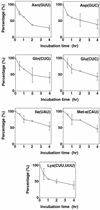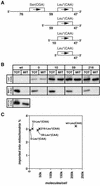tRNAs in Trypanosoma brucei: genomic organization, expression, and mitochondrial import
- PMID: 11997507
- PMCID: PMC133840
- DOI: 10.1128/MCB.22.11.3707-3716.2002
tRNAs in Trypanosoma brucei: genomic organization, expression, and mitochondrial import
Abstract
The mitochondrial genome of Trypanosoma brucei does not encode tRNAs. Consequently, all mitochondrial tRNAs are imported from the cytosol and originate from nucleus-encoded genes. Analysis of all currently available T. brucei sequences revealed that its genome carries 50 tRNA genes representing 40 different isoacceptors. The identified set is expected to be nearly complete since all but four codons are accounted for. The number of tRNA genes in T. brucei is very low for a eukaryote and lower than those of many prokaryotes. Using quantitative Northern analysis we have determined the absolute abundance in the cell and the mitochondrion of a group of 15 tRNAs specific for 12 amino acids. Except for the initiator type tRNA(Met), which is cytosol specific, the cytosolic and the mitochondrial sets of tRNAs were qualitatively identical. However, the extent of mitochondrial localization was variable for the different tRNAs, ranging from 1 to 7.5% per cell. Finally, by using transgenic cell lines in combination with quantitative Northern analysis it was shown that import of tRNA(Leu)(CAA) is independent of its 5'-genomic context, suggesting that the in vivo import substrate corresponds to the mature, fully processed tRNA.
Figures






References
-
- Aphasizhev, R., U. Karmarkar, and L. Simpson. 1998. Are tRNAs imported into mitochondria of kinetoplastid protozoa as 5′-extended precursors? Mol. Biochem. Parasitol. 93:73-80. - PubMed
-
- Béja, O., E. Ullu, and S. Michaeli. 1993. Identification of a tRNA-like molecule that copurifies with the 7SL RNA of Trypanosoma brucei. Mol. Biochem. Parasitol. 57:223-230. - PubMed
-
- Biebinger, S., L. E. Wirtz, P. Lorenz, and C. Clayton. 1996. Vectors for inducible expression of toxic gene products in bloodstream and procyclic Trypanosoma brucei. Mol. Biochem. Parasitol. 85:99-112. - PubMed
-
- Böhringer, S., and H. Hecker. 1975. Quantitative ultrastructural investigations of the life cycle of Trypanosoma brucei: a morphometric analysis. J. Protozool. 22:463-467. - PubMed
-
- Braly, P., L. Simpson, and F. Kretzer. 1974. Isolation of kinetoplast-mitochondrial complexes from Leishmania tarentolae. J. Protozool. 21:782-790. - PubMed
Publication types
MeSH terms
Substances
LinkOut - more resources
Full Text Sources
Other Literature Sources
Miscellaneous
